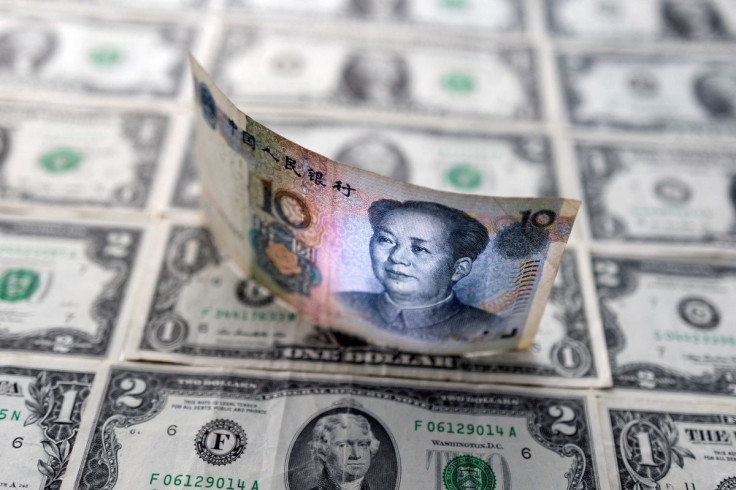Euro Falls To Lowest Since June 2020 As Russia's Invasion Of Ukraine Picks Up

The euro hit its lowest level against the U.S. dollar since June 2020 on Tuesday and the Russian rouble was down in volatile trading as Russia's invasion into Ukraine intensified and oil prices surged.
The U.S. dollar index, which measures the greenback against a basket of currencies, jumped and was last up 0.6%, as investors flocked to safe-haven bets.
Investors were on edge over the latest Ukraine developments. Russia warned Kyiv residents to flee their homes, and Russian commanders shifted tactics to intensify the bombardment of Ukrainian cities.
Brent oil futures had their highest close since August 2014 amid energy shortage concerns. A global agreement to release crude reserves failed to ease worries about supply disruptions from Russia's invasion of Ukraine.
"The likelihood of a '70s-style global oil shock is growing, and investors are moving to safe havens as fast as they can," said Karl Schamotta, chief market strategist at Cambridge Global Payments in Toronto. "The euro is on the front lines here, most exposed to energy shock," with the euro falling as oil and gas prices jump, he said.
Russia's invasion of Ukraine is the biggest assault on a European state since World War Two, and has resulted in Western sanctions that include cutting off some Russian banks from the SWIFT financial network and limiting Moscow's ability to deploy its $630 billion of foreign reserves.
The euro was last down 0.8% on the day at $1.1130 after falling to its lowest level since June 2020. The euro was also down 0.9% against the Japanese yen.
Morgan Stanley analysts said in a Tuesday note they were closing trade recommendations for long euro against the U.S. dollar, yen, pound and the Brazilian real and were "neutral on the euro overall."
"Investors who have assets in Russia that will be increasingly challenging to divest thanks to growing capital controls and sanctions may look at hedging options. Currencies that have a high correlation with RUB risk may be seen as such an option, such as currencies in the CEE area and potentially the EUR," they wrote.
"We will potentially look to re-enter these positions and re-affirm our EUR-bullish thesis in the future should conditions warrant, but, for now, we think it best to keep risk limited and preserve capital for when clearer themes emerge."
The Russian rouble weakened 1.34% versus the greenback to 110.04 per dollar, according to Refinitiv data.
The dollar was down 0.1% against the safe-haven yen.
Earlier, the Swiss franc hit its strongest level since 2015 against the euro.
The Swiss National Bank's sight deposits were little changed in February, suggesting the central bank may have given up its attempts to slow the franc's appreciation.
Bitcoin was up about 2.3%.
========================================================
Currency bid prices at 4:00PM (2100 GMT)
Description RIC Last U.S. Close Pct Change YTD Pct High Bid Low Bid
Previous Change
Session
Dollar index
97.3320 96.7420 +0.63% 1.745% +97.5800 +96.6240
Euro/Dollar
$1.1130 $1.1220 -0.79% -2.09% +$1.1233 +$1.1090
Dollar/Yen
114.8150 114.9700 -0.13% -0.27% +115.2850 +114.7000
Euro/Yen
127.78 128.98 -0.93% -1.95% +129.2400 +127.3800
Dollar/Swiss
0.9182 0.9170 +0.13% +0.66% +0.9205 +0.9150
Sterling/Dollar
$1.3322 $1.3421 -0.72% -1.48% +$1.3437 +$1.3303
Dollar/Canadian
1.2742 1.2669 +0.58% +0.78% +1.2749 +1.2654
Aussie/Dollar
$0.7252 $0.7265 -0.17% -0.22% +$0.7290 +$0.7238
Euro/Swiss
1.0220 1.0283 -0.61% -1.44% +1.0297 +1.0200
Euro/Sterling
0.8352 0.8360 -0.10% -0.57% +0.8368 +0.8317
NZ
Dollar/Dollar $0.6756 $0.6776 -0.29% -1.29% +$0.6790 +$0.6742
Dollar/Norway
8.8805 8.8230 +0.87% +1.03% +8.9145 +8.7760
Euro/Norway
9.8877 9.8771 +0.11% -1.25% +9.9102 +9.8327
Dollar/Sweden
9.6413 9.4849 +1.13% +6.91% +9.6745 +9.4481
Euro/Sweden
10.7338 10.6135 +1.13% +4.88% +10.7479 +10.6016
© Copyright Thomson Reuters 2024. All rights reserved.




















